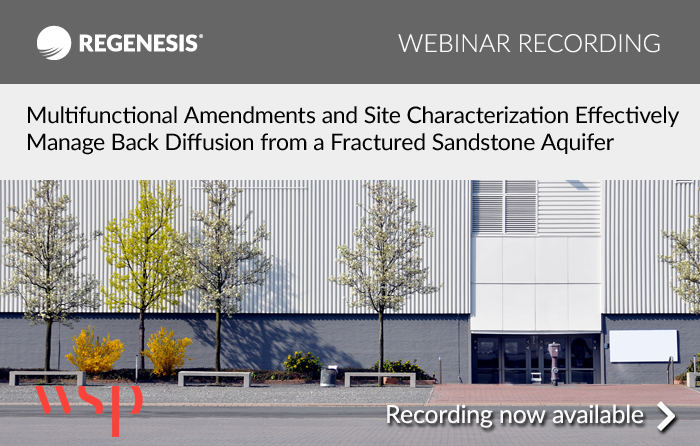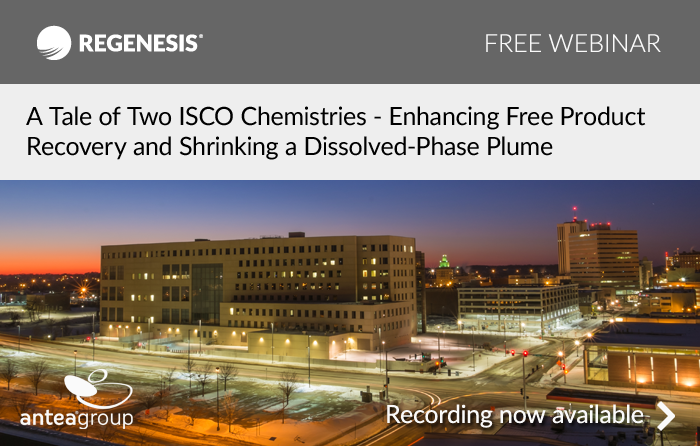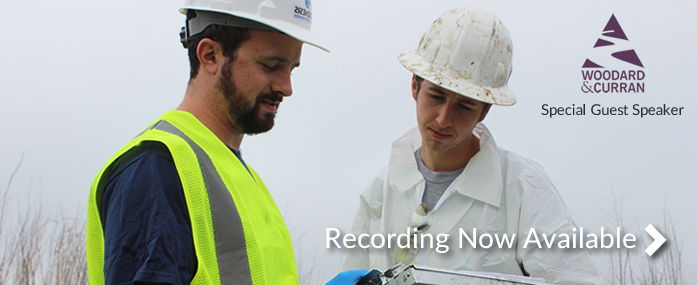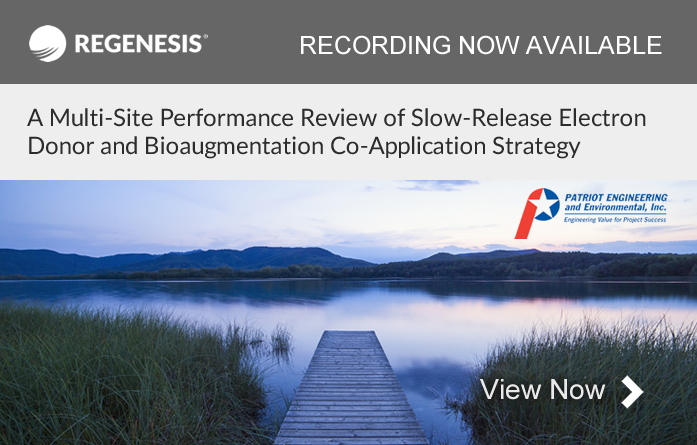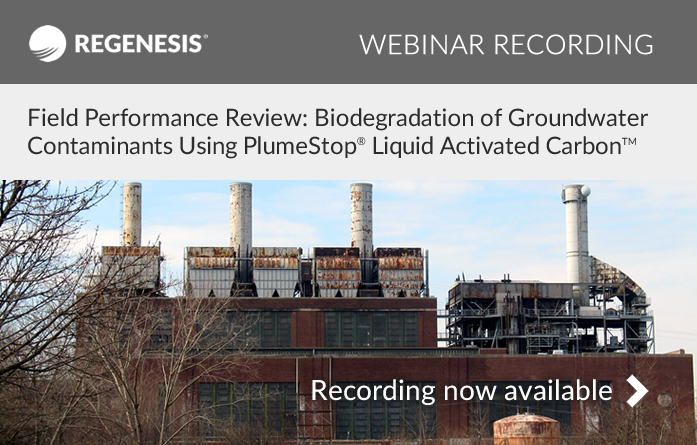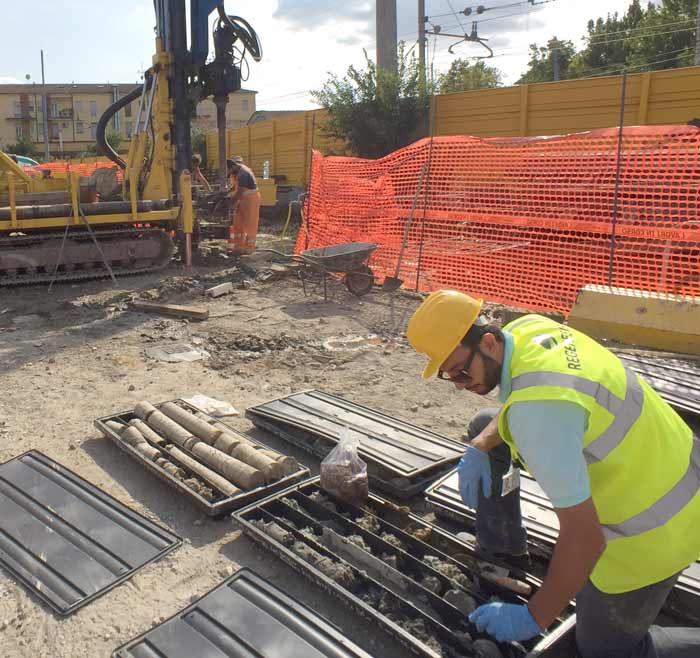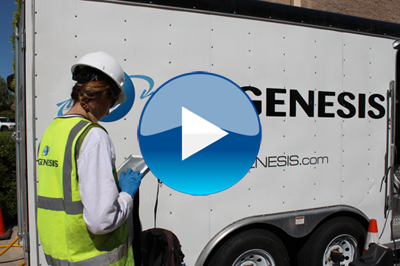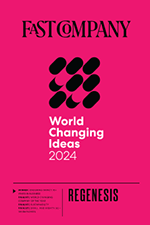Multifunctional Amendments and Site Characterization Effectively Manage Back Diffusion from a Fractured Sandstone Aquifer
First broadcast: June 27, 2017
Speakers: Matthew Burns, Technical Fellow at WSP
Fractured bedrock aquifers can be extremely heterogeneous which not only results in complex dissolved plume behavior but can also hinder in situ remediation efforts that rely on subsurface injection of amendments to promote microbial activity and abiotic degradation. Simply put, injected amendments may bypass or have limited contact time with impacted zones due to transport differences within primary and secondary rock porosity and other subsurface heterogeneities. With thorough characterization of site hydrology, novel amendment formulations, routine performance monitoring, and an adaptive site management approach however,in situ remediation can be successful in fractured bedrock aquifers.
In this webinar we are pleased to have as a special guest speaker Matthew Burns, Technical Fellow and the in situ remediation Practice Leader for WSP. He presents a case study of a site where multifunctional amendments were applied to manage back diffusion of chlorinated VOCs from a fractured sandstone aquifer. He is joined by Maureen Dooley, Director of Strategic Projects at REGENESIS.
Complete the form below to view the recording of this webinar.
Jack Sheldon: A Tale of Two ISCO Chemistries
First broadcast: January 31, 2017
Speakers: Jack Sheldon, Senior Remediation Specialist at Antea Group
In this webinar we’re pleased to have Mr. Jack Sheldon, nationally recognized remediation expert and Senior Remediation Specialist at Antea Group®. Mr. Sheldon’s expertise spans over 34 years of remediation experience and sites in all 50 states and around the world.
His presentation focuses on a case study of a petroleum hydrocarbon impacted site where a sequence of in situ remediation technologies from REGENESIS were applied to address multiple phases of the contamination. The project remediation process, from planning to full implementation, are discussed.
Recording now available
EU Webinar: Field Performance of PlumeStop Liquid Activated Carbon
Recording available in English and in Italian. English Version – First broadcast: Wednesday 30th November 2016. L’edizione italiana di questo webinar è stata presentata da Marcello Carboni e Paola Goria il 1° dicembre.
In this presentation Dr. Jeremy Birnstingl focusses on PlumeStop’s performance in the field. PlumeStop is an innovative in situ groundwater remediation technology which was launched in 2014. Since then, It has been applied on more than 80 sites worldwide, including USA, Canada, Belgium, Italy, UK and Sweden.Read More
Biodegradation of Chlorinated Contaminants Using In Situ Liquid Activated Carbon™
In order to provide more insight into biodegradation of chlorinated solvents using Liquid Activated Carbon, REGENESIS is excited to welcome as a first-time guest webinar presenter, Matthew Valentine, P.G., LRS. Mr. Valentine is Vice President and Project Manager for the environmental engineering and consulting firm Woodard & Curran. He has over 26 years of experience in the environmental industry. During the presentation, he will cover the pilot test and early full scale implementation of a project in South Carolina using the REGENESIS Technology PlumeStop® Liquid Activated Carbon. The contaminated site includes a TCE plume that is over 1,700 feet beyond the source area, and less than 1,000 away from a sensitive receptor. View the webinar recording today to find out why PlumeStop was chosen.
This presentation covers:
- PlumeStop application process, being applied with a slow-release electron donor and bioaugmentation culture to achieve biodegradation of chlorinated solvents in conjunction with the enhanced reductive dechlorination treatment technique
- Initial results from a pilot study in which PlumeStop was selected as the remediation technology
- Full scale implementation of PlumeStop at the site
To access this free webinar recording, use the button below.
A Multi-Site Performance Review of Slow Release Electron Donor and Bioaugmentation Co-Application Strategy
First broadcast: August 25, 2016
Speakers: Steve Sittler, P.G., Senior Project Manager, Patriot Engineering and Environmental
A strategy for co-application of electron donor and bioaugmentation, as well as a multi-site performance review drawing lessons learned for achieving best results, will be the focus of this webinar. We are pleased to have with us Mr. Steven Sittler, P.G., Senior Project Manager at Patriot Engineering and Environmental. Mr. Sittler has more than 30 years of technical experience in applied hydrogeology, with specialized experience in remedial strategy development and implementation.
Mr. Sittler presents strategies for success using co-application of electron donor/bioaugmentation. Recent technological advancements have faciliated a transition towards co-application of controlled-release electron donors and bioaugmentation cultures of Dehalococcoides sp. (DHC). These advancements, including pH neutral electron donors and improved understanding of the viability of DHC, have allowed changes to the old way of thinking of waiting to bioagument. The result is a more aggressive approach with a significant increase in enhanced reductive dechlorination (ERD) rates. Use the form on this page to view this webinar recording today.
Complete the form below to view this free webinar
Field Performance Review: Biodegradation of Groundwater Contaminants using PlumeStop® Liquid Activated Carbon™
First broadcast: July 27, 2016
Speakers: Dr. Jeremy Birnstingl, VP of Environmental Technology at REGENESIS
Dr. Jeremy Birnstingl, VP of Environmental Technology at REGENESIS®, will provide a field performance review of PlumeStop® Liquid Activated Carbon™, a new in situ technology that quickly captures contaminants and accelerates biodegradation while drastically shortening the time frames for reaching groundwater treatment goals. He will share lessons learned from multiple geological settings, and conduct a performance analysis of technology usage to date, reviewing aggregate data from a range of sites across the United States and Europe.
In this presentation will cover:
- Lessons learned from PlumeStop applications in multiple geological settings, including how to ensure the reagent is placed in contaminant flux zones
- How the technology works, securing rapid sorption and long-term biodegradation of contaminants
- Performance analysis of technology usage to date, reviewing aggregate data from a range of sites across the United States and Europe
Bioremediation of Chlorinated Solvents under an Operational Facility
Webinar Recording presented by Dr. Richard Bewley, AECOM Technical Director for UK and Ireland and Dr. Jeremy Birnstingl, REGENESIS. An example of a ‘one-step’ cleanup to site closure of chlorinated ethene contamination under an operational facility with access restricted Read More
Italian Webinar: Casi di studio di trattamento di acquiferi contaminati da idrocarburi mediante desorbimento chimico potenziato
Case study webinar in Italian: Casi di studio di trattamento di acquiferi contaminati da idrocarburi mediante desorbimento chimico potenziatoRead More
PlumeStop Case Studies and First EU Projects
On 3rd November 2015, Dr. Jeremy Birnstingl presented an overview of the PlumeStop technology as well as a selection of the latest case studies including the first PlumeStop projects in Europe. Recording and Presentation AvailableRead More
Remediation Case Studies – Why using Manufacturer-Direct Services Makes a Difference
Using case studies as a basis, the speakers will cover RRS solutions that help environmental consultants develop remediation solutions, effective remediation application designs, and reagent distribution diagnostics in the field.Read More

 Americas
Americas Europe
Europe Français
Français Deutsch
Deutsch Italiano
Italiano Español
Español